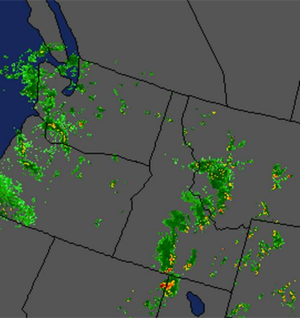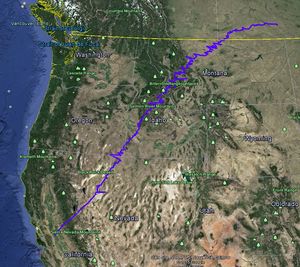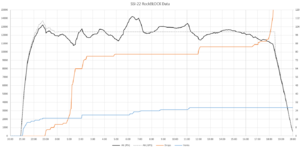SSI-22
SSI-22 was the 22nd launch of SSI Balloons. It outperformed all expectations, launching at 8:52 pm PDT and flying for a over 23 hours through 5 states and 2 countries. It was SSI Balloons' first international flight. The launch was a phenomenal demonstration of the ValBal technology that has been in development for months within SSI. The payload maintained altitude within 12km and 14km as per pre-programmed instructions, and managed to do so autonomosuly - not to mention maintain this altitude in the midst of a thunderstorm without a hitch. SSI-22 landed in Saskatchewan after an approximately 24 hr flight.
Pre-Launch
After being recovered from the SW Nevada Desert, ValBal (previously launched as SSI-21) required some slight repairs due to cracks in acrylic upon landing. After about a week of modifications, repairs, and improvements, the payload was once again flight ready. Some additional adjustments were also made from observations of ValBal's first flight. The team inferred that the valve seal was not airtight (based on data transmitted over satellite communications during SSI-21 and over data logged to SD cards). In response, a latex seal was added to the valve such that closure of the valve would result in compression of the latex seal, producing an airtight fit. This was predicted to help dramatically with gas leaking that was observed during the previous flight.
Some additional features were added to ensure that less power was needed for payload heating. Motor/servo mounts on the payload interior received additional insulation and an enhanced latex seal was attached around the stem connecting the valve to a servo within the payload. Additionally, changes were made in the flight control software to allow enhanced user-to-payload communication and the data sent from the payload was modified to be more useful and descriptive.
Launch site
The launch was conducted at Laird Park, just west of Modesto, CA, the same site used for ValBal's last flight. The team left campus at 4 pm, arriving just after 5:30 pm, and beginning set up and preparations. The payload was essentially flight-ready, requiring only minor pre-flight additions and verification of system fidelity. Fishing line used for the cutdown mechanism was added to the valve, code was re-uploaded and verified, GPS lock was attained, and satellite communications were tested and verified. Although the payload was exempt from regulations requiring FAA tracking, we notified the FAA of the launch and were given a green light to proceed.
Filling of the 1600g Hwoyee balloon began at around 7:45 pm. Filling was more challenging than normal given substantial ground winds, but still concluded successfully. The latex seal on the neck adapter also posed problems as it was not fully considered in the design of the fill valve. An improvisation was made using duct-tape that allowed successful filling of the balloon. Once filled, the balloon and the neck adapter were locked onto the valve mechanism, the ballast hopper was filled, and the balloon was ready to be launched. The balloon was quite overfilled, and hence ascended at faster than most balloons we have launched.
The Flight
The fast ascent rate of the balloon was going to be an immediate test of the resilience and fidelity of the autonomous altitude control algorithm. As soon as the balloon was launched, the team began to pack up while waiting for the first message from the payload. The first message confirmed that the payload was slowly being incentivized to vent gas and slow its ascent. By the time the team had packed up and started driving out, the payload had vented gas a total of 7 times, decreasing its ascent rate to < 1.5 m/s. The algorithm was pre-programmed to maintain an altitude between 12km and 14km. This range of altitudes was chosen to optimize the wind conditions the balloon would experience (fastest winds, most predictable, and most appropriate direction). After the balloon roughly levelled off, the team armed the ballast mechanism over satellite comms. The GPS lock was lost at exactly 12:00 am PDT (due to a snippet of code in the GPS library relying on date, and being unable to cope with the month turnover of May to June). Nonetheless, the satellite communications module transmitted GPS coordinates (albeit with a ~ 4km accuracy).
The payload flew at considerable speed, crossing into Nevada after two hours in the appropriate altitude range. The flight continued through Nevada northward, cutting through the southeastern corner of Oregon before entering Idaho around 2:20 am PDT. The payload spent considerable time in central Idaho, and transmitted data suggesting considerable venting and ballast dropping occurring in this area. Unbeknownst to the team until the balloon was out of Idaho airspace, the balloon flew through a class 3 thunderstorm, experiencing considerable turbulence. Despite the tremendous up and downdrafts, the balloon was able to, autonomously, maintain its altitude within its defined range, at the cost of considerable gas and ballast.
After spending a few hours in the thunderstorm, the balloon entered Montana at around 8:00 am PDT, continuing on a north/northeast trajectory. At 2:39 pm PDT, and at over 1,000 miles from the launch site, the balloon entered Canadian airspace in Saskatchewan province. At this point the balloon began a more prominently eastward flight path along the Canadian border. At around 6:36 PDT, the balloon began a steady descent just north of the North Dakota/Montana border. Based on data transmitted from the balloon, it was clear that the system had ran out of ballast material and was thus unable to drop weight to compensate for lost lift as night was arriving and hence began to fall. The ballooon fell slowly for about an hour, finally terminating its flight at around 8:35 pm EDT, landing in a field.
Debriefing
The ability of the balloon to maintain altitude on its own through almost the entire flight to such precision is a testament to the resilience of the technology. However, problems were encountered, and will be amended in the next iteration of ValBal.
The power draw for heating was quite high; the battery started at a voltage of ~ 4.34 V and was around ~ 3.40 V upon landing. 3.20 V is the point at which the flight control system ceases to function; thus, for longer flights, more power is needed. This will necessitate both more battery storage and, more importantly, solar panels for power regeneration.
Additionally, this flight offered an indication of how far the preloaded quantity of ballast was able to take the balloon. Granted, the turbulence experienced over Idaho resulted in considerable usage of ballast, but it is still clear that significantly more ballast will be required for longer journeys.
Gas venting can also be amended; we have used a 3-inch neck to allow for high volumes of gas to be vented, but this can likely be reduced to a neck diameter as small as 1 inch and compensated for with a larger vent time. Venting for 5 seconds at a time with a 3 inch neck caused unnecessarily large volumes of gas to be vented.
We also intend to better insulate the payload. SSI-18 used a payload wrapped in AeroGel Cryogel blanket, which was so insulative that its heaters did not need to turn on for over 10 hours. A shrinking budget and smaller timeframe did not permit us to put Aerogel on this flight, but it will be a definite component of future payload containers.
Milestones
- First international launch of SSI Balloons
- Longest flight of SSI Balloons
- Longest ground distance traveled by any SSI Balloons mission



